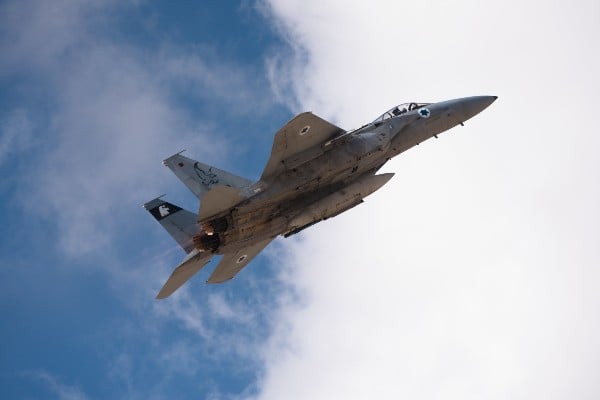Analyst citing commercial satellite imagery says Israel appears to have targeted infrastructure used for mixing ballistic missile fuel, which Iran ‘will likely have a hard time replacing.’
By Ben Rappaport, United with Israel and Charles Bybelezer, JNS
Israeli Air Force fighter jets conducted precision strikes on military targets in Iran overnight Friday, nearly one month after Tehran launched a massive ballistic-missile attack on the Jewish state.
According to the Israel Defense Forces, dozens of aircraft, including refuelers and spy planes, conducted “waves” of attacks over the course of a few hours across several regions of Iran, located some 1,600 kilometers from Israel. The targets included missile and drone manufacturing facilities and launch sites, as well as air-defense batteries.
The state-run SANA news outlet reported simultaneous Israeli strikes against military targets across central and southern Syria, amid Tehran’s decades-long effort to entrench itself in that country.
The IDF named the operation “Days of Repentance.”
“I can now confirm that we have concluded the Israeli response to Iran’s attacks against Israel. We conducted targeted and precise strikes on military targets in Iran—thwarting immediate threats to the State of Israel,” said IDF Spokesman Rear Adm. Daniel Hagari.
“The Israel Defense Forces has fulfilled its mission. If the regime in Iran were to make the mistake of beginning a new round of escalation, we will be obligated to respond. Our message is clear: All those who threaten the State of Israel and seek to drag the region into wider escalation will pay a heavy price,” Hagari continued.
“We demonstrated today that we have both the capability and the resolve to act decisively, and we are prepared—on offense and defense—to defend the State of Israel and the people of Israel,” he added.
The Biden administration was informed of the strikes in advance, but the United States did not directly participate in the action.
Speaking to Reuters in a report published Sunday, Decker Eveleth, an associate research analyst at CNA, a Washington think tank, assessed based on commercial satellite imagery that the Israeli strikes may have “significantly hampered Iran’s ability to mass produce missiles.”
Eveleth said an image from Planet Labs, a commercial satellite firm, showed that Israel had destroyed three ballistic missile solid fuel mixing buildings and a warehouse in Parchin, a giant military complex near Tehran.
In addition, he said, the Planet Labs imagery showed that an Israeli strike had destroyed two buildings, located in the massive Khojir missile production complex near Tehran, in which solid fuel for ballistic missiles was mixed.
Reuters said it had seen an image indicating the buildings were enclosed by high dirt berms, which are associated with missile production due to their usefulness in blocking chain reactions of explosions between buildings should there be an explosion in one building.
“Israel says they targeted buildings housing solid-fuel mixers,” Eveleth said. “These industrial mixers are hard to make and export-controlled. Iran imported many over the years at great expense, and will likely have a hard time replacing them.”
Though limited in scope, Israel’s operation, he said, may have struck a significant blow to Iran’s ability to mass-produce missiles, making it harder for Iranian missiles to get past Israeli missile defense in the future.
“The strikes appear to be highly accurate,” he added.
Three Iranian officials cited by the New York Times said that Israel’s destruction of Iranian air-defense systems has raised “deep alarm” in Iran, as Iranian energy and economic sites are now vulnerable to attack should military confrontations between Israel and Iran continue.
“Israel is sending a clear message to us,” Hamid Hosseini, an expert on Iran’s oil and gas industry and a member of the Iran-Iraq Chamber of Commerce, said according to the New York Times.
“This can have very serious economic consequences for Iran, and now that we understand the stakes we need to act wise and not continue the tensions,” he added.
